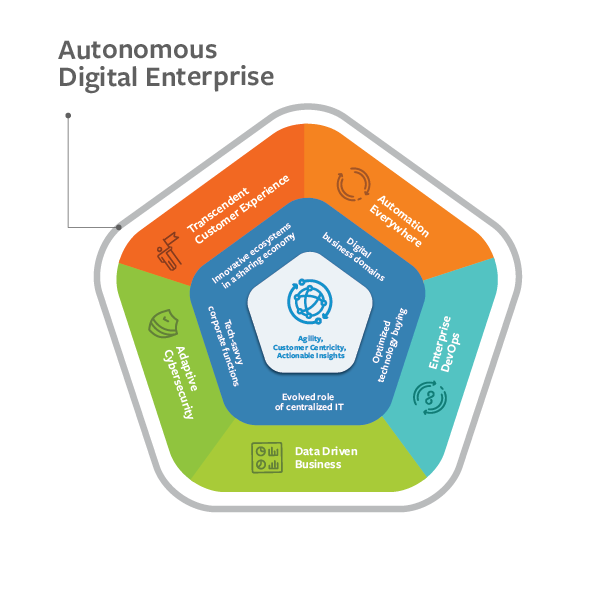Presented by BMC
We were already poised to see seismic changes over the next five to ten years in every industry sector. Now the future has suddenly become impossible to predict; COVID-19 has shaken up global markets, with full consequences not yet known on a wider scale. Suddenly, companies are needing to both consider how to protect their businesses and people right now, while maximizing their ability to thrive in the future.
Companies have often underestimated the impact of future trends — the shakeups being brought about by the fourth industrial revolution in particular. We’re in the early stages yet, but transformational technology has already changed the way we live, work, and relate to one another globally. Revolutionary changes, increasingly merging human and machine, have been slowly shaping the future. And now they’re more essential to the functioning of our society and economy than any futurist could have predicted.
Pervasive connectivity, the proliferation of data across platforms, along with business and science innovations, have been upending established business models.
To thrive, every organization will need to evolve to an Autonomous Digital Enterprise, a state where intelligent, integrated, value-creating functions can operate with minimal human involvement or interference, across every facet of the organization and its ecosystem of partners.
By 2025, technology will underpin every successful company, drive every business function, and span customer relationships, business operations, and people management — every successful company will be a tech company. But now is the time to start reinventing, embracing that next-gen business model in order to meet that deadline.
The tools to pivot, adapt, and thrive
What does it take to be an Autonomous Digital Enterprise? It starts with embracing new approaches to talent management, an evolution of the IT organization, working across the value stream with an ecosystem of business partners, and optimizing technology buying strategies. People’s functions in the enterprise need to evolve to new roles that require human judgement and support the autonomous systems that run the business. Work in the future will shift as technology takes on the mundane and repetitive tasks across the business and employees shift to higher-value responsibilities.
Here’s a closer look at the essential operating model characteristics of an Autonomous Digital Enterprise:
- Innovation ecosystems in a sharing economy: Embracing non-traditional outside partners and completely different industries enlarges a business’s sensing capabilities, adds access to new talent, establishes an environment of experimentation, and adds support for the new tech-first business model.
- Digital business domains: Interdisciplinarity teams, design-thinking techniques, and new attention to employee experiences enable workers to be more flexible and contribute to multiple cross-team projects and activities that evolve dynamically based on customer and business needs. Teams can focus on new innovation without disrupting current operations.
- Optimized technology buying: Technology becomes the responsibility of each business unit and individual employees, empowering them to embrace the new opportunities that technology unlocks — an increasing trend of users also being buyers.
- Evolved role of centralized IT: The majority of tech spend moves to innovation initiatives, with decisions driven by the business, supported by functional IT, in order to foster greater agility and more opportunities for innovation and growth.
- Tech-savvy corporate functions: Technology is embraced as a force for good, with automation and artificial intelligence enabling the redesign of work, enhancing productivity and customer experience, and enabling a focus on more value-added tasks.

The technology-driven enablers of an Autonomous Digital Enterprise include transcendent customer experience, automation everywhere, enterprise DevOps, data-driven business, and adaptive cybersecurity.
Here’s a look at how companies are embracing the Autonomous Digital Enterprise tenets to transform their businesses now and position themselves for the future.
Success now and in 2025
Aviva, one of Europe’s largest insurers, is a best-case study of delivering a transcendent customer experience to help reinvent itself without disrupting current operations. The company has embraced the automated management of its application releases as well as fixes and enhancements to keep its production system agile. It’s able to rapidly and securely deploy individual production changes as soon as they are available without taking down revenue-generating websites.
This has cut overhead costs, improved efficiency, and let the company pass the cost savings on to its clients. The company is now able to stay agile in the market and extremely competitive in its ability to meet consumer demands. Its website is always-on to allow customers to conduct business seamlessly, without ever encountering downtime, and on their own schedules. Company employees are never required to work overtime or weekends to meet deadlines, meaning company morale and employee experience is also significantly enhanced.
The company’s IT folk are also freed up from mundane responsibilities like managing or securing update deployments, so that they can now focus their time collaborating on more valuable work with more generative possibilities.
Automation everywhere for enterprise DevOps
Becoming an Autonomous Digital Enterprise also enables employees to focus less on the repetitive and more on higher-value business initiatives. CarFax’s business strategy is a strong case in point. The company has embraced DevOps — which aligns developers, IT operations, sales, marketing, and finance in ways that were not possible before — to deploy new features faster and with better business alignment. The addition of automation, Control-M by BMC, lets them speed up the DevOps process even more.
Workload automation allows developers to push code to production in a safe and secure manner that complies with operational rules, eliminating the need to bring in an operations person. This helps free up the operations team to do other work.
Ultimately, the more the company gives their people access to processes, the more they actually take ownership of them, freeing up teams to focus on high-value transformative business initiatives.
Preparing now for the future
It all comes down to this: it is absolutely essential to embrace great customer experience, automation everywhere, enterprise DevOps, and data-driven actionable insights. Enterprises that go all in on these constant tech-enabled disruptions to continuously adapt and evolve will be the dominant players in their respective industries in the decade ahead.
Dig deeper: Learn more about integrating AI and automation into your business with BMC.
Sponsored articles are content produced by a company that is either paying for the post or has a business relationship with VentureBeat, and they’re always clearly marked. Content produced by our editorial team is never influenced by advertisers or sponsors in any way. For more information, contact sales@venturebeat.com.

